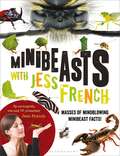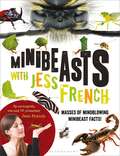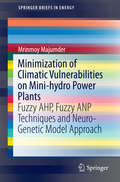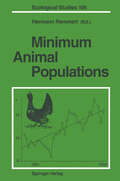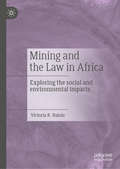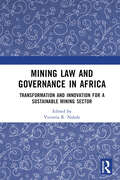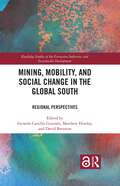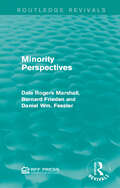- Table View
- List View
Mineral Wealth and Economic Development (Routledge Revivals)
by John E. TiltonOver the last several decades, many low-income mineral exporting countries have seen their per capita income decline or their standard of living stagnate. In this title, prominent analysts identify reasons behind the distressing economic performance of these countries including ineffective public policies, political misuse of mineral rents, and the deleterious effects of economic nationalism on the foreign investment climate in developing countries. Originally published in 1992, this title remains relevant for students interested in environmental studies and public policy.
Mineral Wealth and Economic Development (Routledge Revivals)
by John E. TiltonOver the last several decades, many low-income mineral exporting countries have seen their per capita income decline or their standard of living stagnate. In this title, prominent analysts identify reasons behind the distressing economic performance of these countries including ineffective public policies, political misuse of mineral rents, and the deleterious effects of economic nationalism on the foreign investment climate in developing countries. Originally published in 1992, this title remains relevant for students interested in environmental studies and public policy.
Minerals Handbook 1992–93: Statistics and Analyses of the World’s Minerals Industry
by Phillip CrowsonThe statistics in this book cover 48 minerals and provide information on world reserves, world mine production, reserve/production ratios, world smelter production, world capacity, consumption by country/region, end use patterns, substitutes, technical possibilities, prices, marketing arrangements.
Minesite Recultivation
by Reinhard F. Hüttl, Thomas Heinkele and Joe WisniewskiInternational Symposium, Cottbus, Germany, 6-8 June 1994
Mini Meadows: Grow a Little Patch of Colorful Flowers Anywhere around Your Yard
by Mike LizotteCreate low-cost, low-maintenance flower-filled plots around the yard that provide habitat for pollinators, reduce mowing, and address problem areas with special plantings for shady, damp, erosion-prone, or deer-susceptible spots.
Minibeasts with Jess French: Masses of mindblowing minibeast facts!
by Jess FrenchFancy meeting a foot-long centipede or a spider the size of your dinner plate? Willing to let the world's weirdest and most fascinating minibeasts join you on your sofa?Then allow Jess French to lead you head first through the unbelievable world of invertebrates and explore their incredible adaptations, from dancing scorpions and blood-sucking moths to zombie spiders and slime-shooting worms.Marvel at how minibeasts have evolved to survive in almost every describable habitat. Discover the fascinating ways they find food, mate, fight, hide and collaborate in even the most extreme conditions! And pore over more than 250 breathtakingly detailed photographs of astonishing invertebrates.With her unparalled zeal for minibeasts, Jess will enlighten you on the most fascinating and intense aspects of the minibeast world, revealing everything from cloaks made of corpses to mid-flight kamikaze mating.
Minibeasts with Jess French: Masses of mindblowing minibeast facts!
by Jess FrenchFancy meeting a foot-long centipede or a spider the size of your dinner plate? Willing to let the world's weirdest and most fascinating minibeasts join you on your sofa?Then allow Jess French to lead you head first through the unbelievable world of invertebrates and explore their incredible adaptations, from dancing scorpions and blood-sucking moths to zombie spiders and slime-shooting worms.Marvel at how minibeasts have evolved to survive in almost every describable habitat. Discover the fascinating ways they find food, mate, fight, hide and collaborate in even the most extreme conditions! And pore over more than 250 breathtakingly detailed photographs of astonishing invertebrates.With her unparalled zeal for minibeasts, Jess will enlighten you on the most fascinating and intense aspects of the minibeast world, revealing everything from cloaks made of corpses to mid-flight kamikaze mating.
Minimization of Climatic Vulnerabilities on Mini-hydro Power Plants: Fuzzy AHP, Fuzzy ANP Techniques and Neuro-Genetic Model Approach (SpringerBriefs in Energy)
by Mrinmoy MajumderThis Brief presents the multi criteria decision making (MCDM) techniques like Fuzzy Analytical Hierarchy Process (AHP) and Fuzzy Analytical Network Process (ANP) to find out the importance of the influencing factors to develop the Climatic Vulnerability Index (CVI) that will represent the vulnerability of the Hydro-Power Plant (HPP) to climatic abnormalities. The cognitive ability of neuro-genetic modeling is applied to minimize CVI so that the conditions required to reduce the effect of climate change on HPP can be identified. The results from the study are found to be encouraging. The scarcity and pollution potential of conventional sources of energy has enforced scientists worldwide to look for efficient, flexible, cost effective but reliable alternative energy resources. Among many available options the energy extracted from water was found to be the least expensive, most flexible and moderately reliable renewable energy source which has the potential to replace the dependency on conventional fuels.
Minimum Animal Populations (Ecological Studies #106)
by Hermann RemmertH. REMMERT Small populations are very often discussed, but there seems to be no general overview touching all the self-evident but norma,lly simply neglected problems connected with small populations. First, there are many very different types of organisms, and as every biologist should know, the problems of small populations are very different in different types of organisms. 1. In vascular plants the problems are different from the situation in birds and mammals; in marine benthic animals or in parasites such as tapeworms the problems are different again, and in seasonal planktonic animals or insects they are different from those in biotopes under constant conditions. In tapeworms or in vascular plants, an adult organism seems to be comparable to a population of mammals or birds because its offspring can be so diverse and plentiful. 2. There are small populations which explode and break down to a small population again, and then explode and break down again.
Mining and Indigenous Livelihoods: Rights, Revenues, and Resistance (Routledge Studies of the Extractive Industries and Sustainable Development)
by Andrew Taylor Sophie Thériault Thierry Rodon Arn Keeling Séverine BouardThis book maps the encounters between Indigenous Peoples and local communities with mining companies in various postcolonial contexts.Combining comparative and multidisciplinary analysis, the contributors to this volume shine a light on how the mining industry might adapt its practices to the political and legal contexts where they operate. Understanding these processes and how communities respond to these encounters is critical to documenting where and how encounters with mining may benefit or negatively impact Indigenous Peoples. The experiences and reflections shared by Indigenous and non-Indigenous contributors will enhance our understanding of evolving practices and of the different strategies and discourses developed by Indigenous Peoples to deal with mining projects. By mobilizing in-depth fieldwork in five regions—Australia, Canada, Sweden, New Caledonia, and Brazil—this body of work highlights voices often marginalized in mining development studies, including those of Indigenous Peoples and women.This book will be of great interest to students and scholars of mining and the extractive industries, sustainable development, natural resource management, and Indigenous Peoples.The Open Access version of this book, available at http://www.taylorfrancis.com, has been made available under a Creative Commons Attribution-Non Commercial-No Derivatives (CC-BY-NC-ND) 4.0 license.
Mining and Indigenous Livelihoods: Rights, Revenues, and Resistance (Routledge Studies of the Extractive Industries and Sustainable Development)
This book maps the encounters between Indigenous Peoples and local communities with mining companies in various postcolonial contexts.Combining comparative and multidisciplinary analysis, the contributors to this volume shine a light on how the mining industry might adapt its practices to the political and legal contexts where they operate. Understanding these processes and how communities respond to these encounters is critical to documenting where and how encounters with mining may benefit or negatively impact Indigenous Peoples. The experiences and reflections shared by Indigenous and non-Indigenous contributors will enhance our understanding of evolving practices and of the different strategies and discourses developed by Indigenous Peoples to deal with mining projects. By mobilizing in-depth fieldwork in five regions—Australia, Canada, Sweden, New Caledonia, and Brazil—this body of work highlights voices often marginalized in mining development studies, including those of Indigenous Peoples and women.This book will be of great interest to students and scholars of mining and the extractive industries, sustainable development, natural resource management, and Indigenous Peoples.The Open Access version of this book, available at http://www.taylorfrancis.com, has been made available under a Creative Commons Attribution-Non Commercial-No Derivatives (CC-BY-NC-ND) 4.0 license.
Mining and Selling Radium and Uranium
by Roger F. RobisonPresented here is the story of the mining and sale of uranium and radium ore through biographical vignettes, chemistry, physics, geology, geography, occupational health, medical utilization, environmental safety and industrial history. Included are the people and places involved over the course of over 90 years of interconnected mining and sale of radium and uranium, finally ending in 1991 with the abandonment of radium paint and medical devices, Soviet nuclear parity, and the Radiation Exposure Compensation Act.
Mining and Social Transformation in Africa: Mineralizing and Democratizing Trends in Artisanal Production (Routledge Studies in Development and Society)
by Deborah Fahy Bryceson Eleanor Fisher Jesper Bosse Jønsson Rosemarie MwaipopoAfter more than three decades of economic malaise, many African countries are experiencing an upsurge in their economic fortunes linked to the booming international market for minerals. Spurred by the shrinking viability of peasant agriculture, rural dwellers have been engaged in a massive search for alternative livelihoods, one of the most lucrative being artisanal mining. While an expanding literature has documented the economic expansion of artisanal mining, this book is the first to probe its societal impact, demonstrating that artisanal mining has the potential to be far more democratic and emancipating than preceding modes. Delineating the paradoxes of artisanal miners working alongside the expansion of large-scale mining investment in Africa, Mining and Social Transformation in Africa concentrates on the Tanzanian experience. Written by authors with fresh research insights, focus is placed on how artisanal mining is configured in relation to local, regional and national mining investments and social class differentiation. The work lives and associated lifestyles of miners and residents of mining settlements are brought to the fore, asking where this historical interlude is taking them and their communities in the future. The question of value transfers out of the artisanal mining sector, value capture by elites and changing configurations of gender, age and class differentiation, all arise.
Mining and Social Transformation in Africa: Mineralizing and Democratizing Trends in Artisanal Production (Routledge Studies in Development and Society)
by Deborah Fahy Bryceson Eleanor Fisher Jesper Bosse Jønsson Rosemarie MwaipopoAfter more than three decades of economic malaise, many African countries are experiencing an upsurge in their economic fortunes linked to the booming international market for minerals. Spurred by the shrinking viability of peasant agriculture, rural dwellers have been engaged in a massive search for alternative livelihoods, one of the most lucrative being artisanal mining. While an expanding literature has documented the economic expansion of artisanal mining, this book is the first to probe its societal impact, demonstrating that artisanal mining has the potential to be far more democratic and emancipating than preceding modes. Delineating the paradoxes of artisanal miners working alongside the expansion of large-scale mining investment in Africa, Mining and Social Transformation in Africa concentrates on the Tanzanian experience. Written by authors with fresh research insights, focus is placed on how artisanal mining is configured in relation to local, regional and national mining investments and social class differentiation. The work lives and associated lifestyles of miners and residents of mining settlements are brought to the fore, asking where this historical interlude is taking them and their communities in the future. The question of value transfers out of the artisanal mining sector, value capture by elites and changing configurations of gender, age and class differentiation, all arise.
Mining and the Environment: From Ore to Metal
by Karlheinz Spitz John TrudingerThe history of mining is replete with controversy of which much is related to environmental damage and consequent community outrage. Over recent decades, this has led to increased pressure to improve the environmental and social performance of mining operations, particularly in developing countries. The industry has responded by embracing the ideals of sustainability and corporate social responsibility. Mining and the Environment identifies and discusses the wide range of social and environmental issues pertaining to mining, with particular reference to mining in developing countries, from where many of the project examples and case studies have been selected. Following an introductory overview of pressing issues, the book illustrates how environmental and social impact assessment, such as defined in "The Equator Principles", integrates with the mining lifecycle and how environmental and social management aims to eliminate the negative and accentuate the positive mining impacts. Practical approaches are provided for managing issues ranging from land acquisition and resettlement of Indigenous peoples, to the technical aspects of acid rock drainage and mine waste management. Moreover, thorough analyses of ways and means of sharing non-transitory mining benefits with host communities are presented to allow mining to provide sustainable benefits for the affected communities. This second edition of Mining and the Environment includes new chapters on Health Impact Assessment, Biodiversity and Gender Issues, all of which have become more important since the first edition appeared a decade ago. The wide coverage of issues and the many real-life case studies make this practice-oriented book a reference and key reading. It is intended for environmental consultants, engineers, regulators and operators in the field and for students to use as a course textbook. As much of the matter applies to the extractive industries as a whole, it will also serve environmental professionals in the oil and gas industries. Karlheinz Spitz and John Trudinger both have multiple years of experience in the assessment of mining projects around the world. The combination of their expertise and knowledge about social, economic, and environmental performance of mining and mine waste management has resulted in this in-depth coverage of the requirements for responsible and sustainable mining.
Mining and the Environment: From Ore to Metal
by Karlheinz Spitz John TrudingerThe history of mining is replete with controversy of which much is related to environmental damage and consequent community outrage. Over recent decades, this has led to increased pressure to improve the environmental and social performance of mining operations, particularly in developing countries. The industry has responded by embracing the ideals of sustainability and corporate social responsibility. Mining and the Environment identifies and discusses the wide range of social and environmental issues pertaining to mining, with particular reference to mining in developing countries, from where many of the project examples and case studies have been selected. Following an introductory overview of pressing issues, the book illustrates how environmental and social impact assessment, such as defined in "The Equator Principles", integrates with the mining lifecycle and how environmental and social management aims to eliminate the negative and accentuate the positive mining impacts. Practical approaches are provided for managing issues ranging from land acquisition and resettlement of Indigenous peoples, to the technical aspects of acid rock drainage and mine waste management. Moreover, thorough analyses of ways and means of sharing non-transitory mining benefits with host communities are presented to allow mining to provide sustainable benefits for the affected communities. This second edition of Mining and the Environment includes new chapters on Health Impact Assessment, Biodiversity and Gender Issues, all of which have become more important since the first edition appeared a decade ago. The wide coverage of issues and the many real-life case studies make this practice-oriented book a reference and key reading. It is intended for environmental consultants, engineers, regulators and operators in the field and for students to use as a course textbook. As much of the matter applies to the extractive industries as a whole, it will also serve environmental professionals in the oil and gas industries. Karlheinz Spitz and John Trudinger both have multiple years of experience in the assessment of mining projects around the world. The combination of their expertise and knowledge about social, economic, and environmental performance of mining and mine waste management has resulted in this in-depth coverage of the requirements for responsible and sustainable mining.
Mining and the Law in Africa: Exploring the social and environmental impacts
by Victoria R. NaluleThe mining sector has been an integral part of economic development in many African countries. Although minerals have been exploited for decades in these countries, the benefits have not always been as visible. This has necessitated reforms including nationalisation of mining activities in the distant past; and currently legal and regulatory reforms. This book gives an insight of these reforms and with reference to the fieldwork research undertaken by the author in some African countries, the book highlights the social and environmental impacts of mining activities in Africa. The central question of the book is, why the mining laws have worked in some countries but not others and what can be done to ensure that these laws are effective? Consequently, the book analyses the legal reforms made in the sector and highlights both the challenges and the opportunities for foreign investors as well as the African governments and local communities. The book will be of great interest to researchers and students in Energy and Geography related fields, as well as to practitioners and policy makers.
The Mining Law: A Study in Perpetual Motion (Routledge Revivals)
by John D. LeshyOriginally published in 1987, John D. Leshy presents this scholarly study of the 1872 Mining Law as a legal treatise and history of mining in the West from the point of view of mineral exploration and production. This mining law governed the United States mining practice yet had never been changed. The Mining Law attempts to highlight the role of policy and government as well as the more obscure elements of the law which complicated mining practice in the eighties. This title will be of interest to students of Environmental Studies and policy makers.
The Mining Law: A Study in Perpetual Motion (Routledge Revivals)
by John D. LeshyOriginally published in 1987, John D. Leshy presents this scholarly study of the 1872 Mining Law as a legal treatise and history of mining in the West from the point of view of mineral exploration and production. This mining law governed the United States mining practice yet had never been changed. The Mining Law attempts to highlight the role of policy and government as well as the more obscure elements of the law which complicated mining practice in the eighties. This title will be of interest to students of Environmental Studies and policy makers.
Mining Law and Governance in Africa: Transformation and Innovation for a Sustainable Mining Sector
by Victoria R. NaluleThis book explores the various issues that characterise the African mining sector, drawing examples from different African countries and regional organisations. Although there is a massive literature on the subject, some issues have been neglected, including the crucial role of digitalisation and technological advancement in resolving the environmental and social challenges faced in Artisanal and Small-Scale Mining (ASM), deep-sea mining, mining contract negotiations and modernising mining laws to reflect the increasing role of critical minerals, to mention but a few. Therefore, the book unpacks the critical issues associated with the mining sector, explicitly reflecting on the practical solutions needed to address the challenges in the African mining sector. This book uniquely analyses and adds flavour to international mining’s fundamental concepts by describing a simulated annealing-based approach appropriate for complex mining projects in Africa. Book contributors comprise of academics from different universities including professors, practitioners, government policymakers, NGO executives and a variety of different experts. This multidisciplinary book will be of interest to African policymakers, governments, academics, industry professionals, energy and mining institutions, international organisations, universities across the globe and companies.
Mining Law and Governance in Africa: Transformation and Innovation for a Sustainable Mining Sector
This book explores the various issues that characterise the African mining sector, drawing examples from different African countries and regional organisations. Although there is a massive literature on the subject, some issues have been neglected, including the crucial role of digitalisation and technological advancement in resolving the environmental and social challenges faced in Artisanal and Small-Scale Mining (ASM), deep-sea mining, mining contract negotiations and modernising mining laws to reflect the increasing role of critical minerals, to mention but a few. Therefore, the book unpacks the critical issues associated with the mining sector, explicitly reflecting on the practical solutions needed to address the challenges in the African mining sector. This book uniquely analyses and adds flavour to international mining’s fundamental concepts by describing a simulated annealing-based approach appropriate for complex mining projects in Africa. Book contributors comprise of academics from different universities including professors, practitioners, government policymakers, NGO executives and a variety of different experts. This multidisciplinary book will be of interest to African policymakers, governments, academics, industry professionals, energy and mining institutions, international organisations, universities across the globe and companies.
Mining, Mobility, and Social Change in the Global South: Regional Perspectives (Routledge Studies of the Extractive Industries and Sustainable Development)
by Gerardo Castillo Guzmán Matthew Himley David BreretonThis volume focuses on how, why, under what conditions, and with what effects people move across space in relation to mining, asking how a focus on spatial mobility can aid scholars and policymakers in understanding the complex relation between mining and social change. This collection centers the concept of mobility to address the diversity of mining-related population movements as well as the agency of people engaged in these movements. This volume opens by introducing both the historical context and conceptual tools for analyzing the mining-mobility nexus, followed by case study chapters focusing on three regions with significant histories of mineral extraction and where mining currently plays an important role in socio-economic life: the Andes, Central and West Africa, and Melanesia. Written by authors with expertise in diverse fields, including anthropology, development studies, geography, and history, case study chapters address areas of both large- and smallscale mining. They explore the historical-geographical factors shaping mining-related mobilities, the meanings people attach to these movements, and the relations between people’s mobility practices and the flows of other things put in motion by mining, including capital, ideas, technologies, and toxic contamination. The result is an important volume that provides fresh insights into the social geographies and spatial politics of extraction. This book will be of great interest to students and scholars of mining and the extractive industries, spatial politics and geography, mobility and migration, development, and the social and environmental dimensions of natural resources more generally.
Mining, Mobility, and Social Change in the Global South: Regional Perspectives (Routledge Studies of the Extractive Industries and Sustainable Development)
This volume focuses on how, why, under what conditions, and with what effects people move across space in relation to mining, asking how a focus on spatial mobility can aid scholars and policymakers in understanding the complex relation between mining and social change. This collection centers the concept of mobility to address the diversity of mining-related population movements as well as the agency of people engaged in these movements. This volume opens by introducing both the historical context and conceptual tools for analyzing the mining-mobility nexus, followed by case study chapters focusing on three regions with significant histories of mineral extraction and where mining currently plays an important role in socio-economic life: the Andes, Central and West Africa, and Melanesia. Written by authors with expertise in diverse fields, including anthropology, development studies, geography, and history, case study chapters address areas of both large- and smallscale mining. They explore the historical-geographical factors shaping mining-related mobilities, the meanings people attach to these movements, and the relations between people’s mobility practices and the flows of other things put in motion by mining, including capital, ideas, technologies, and toxic contamination. The result is an important volume that provides fresh insights into the social geographies and spatial politics of extraction. This book will be of great interest to students and scholars of mining and the extractive industries, spatial politics and geography, mobility and migration, development, and the social and environmental dimensions of natural resources more generally.
Minority Perspectives (Routledge Revivals)
by Dale Rogers Marshall Bernard Frieden Daniel Wm. FesslerOriginally published in 1972, Minority Perspectives is the second in a series exploring metropolitan problems within the government structure. The 1960’s were a period of civils rights movements as well as poverty in the United States and in the 70’s, it became clear that poverty was closely linked to race. This report sets out to explore issues contributing to the metropolitan-minority poverty problem such as racial exclusion and public policy. The papers included in this report discuss issues such as political power in metropolitan areas, the impact an address can have on economic opportunity for minority groups and the effects that laws and litigation can have on poverty. This title will be of interest to students of environmental and urban studies.
Minority Perspectives (Routledge Revivals)
by Dale Rogers Marshall Bernard Frieden Daniel Wm. FesslerOriginally published in 1972, Minority Perspectives is the second in a series exploring metropolitan problems within the government structure. The 1960’s were a period of civils rights movements as well as poverty in the United States and in the 70’s, it became clear that poverty was closely linked to race. This report sets out to explore issues contributing to the metropolitan-minority poverty problem such as racial exclusion and public policy. The papers included in this report discuss issues such as political power in metropolitan areas, the impact an address can have on economic opportunity for minority groups and the effects that laws and litigation can have on poverty. This title will be of interest to students of environmental and urban studies.




